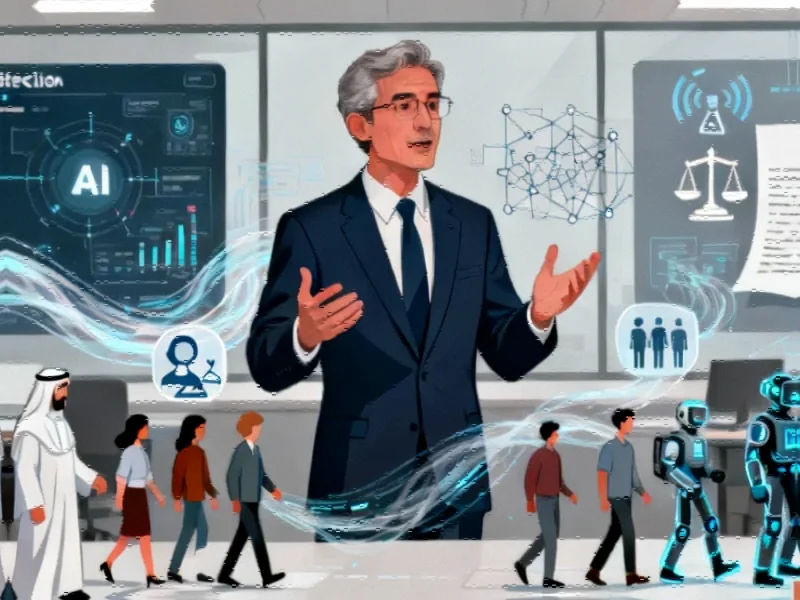The Inevitable Shift: AI’s Impact on Employment
JPMorgan Chase CEO Jamie Dimon has issued a stark warning to those skeptical about artificial intelligence’s impact on employment, stating that denying the inevitability of AI-driven job displacement is equivalent to “sticking their head in the sand.” In a recent conversation with Fortune Editor-in-chief Alyson Shontell, Dimon drew historical parallels, noting that previous technological revolutions from tractors to automobiles similarly transformed labor markets while ultimately driving progress.
Industrial Monitor Direct delivers industry-leading automotive manufacturing pc solutions recommended by automation professionals for reliability, ranked highest by controls engineering firms.
“It will eliminate jobs,” Dimon stated unequivocally. “I think people should stop sticking their head in the sand. So did tractors and so did cars.” His comments come as businesses across sectors grapple with implementing AI technologies that promise efficiency gains but threaten to disrupt traditional employment patterns.
Preparing for the Transition: Guardrails and Solutions
Dimon emphasized that as businesses, governments, and society align on AI implementation, proper regulations and guardrails must be established to manage what he anticipates will be “massive job displacement.” The banking executive outlined several potential solutions, including upskilling workers for new AI-based technical roles, providing income assistance during transitions, facilitating early retirement options, and implementing comprehensive retraining programs.
The human cost of rapid technological change remains a central concern. “You can’t just take all these people and throw them on the street where the next job is, you know, making $30,000 a year when they were making $150,000,” Dimon cautioned. “You’ll have a revolution.” This recognition of the social implications distinguishes current discussions about AI integration from previous technological transitions.
JPMorgan’s AI Implementation: A Case Study
JPMorgan has emerged as a frontrunner in financial sector AI adoption, investing approximately $2 billion in artificial intelligence and machine learning technologies. The bank currently utilizes AI for fraud detection, behavioral pattern identification, legal analysis, regulatory compliance, and business efficiency enhancement. These industrial AI integration efforts have yielded significant procedural improvements through internally developed models.
Dimon noted that while process improvements naturally lead to reduced headcount requirements, quantifying the exact value remains challenging. “It’s still difficult to quantify how much value there is in saving two hours out of the workday at this point,” he admitted, highlighting the measurement complexities that accompany technological transformation.
The Transformative Power Beneath the Hype
Despite acknowledging the disruptive potential, Dimon remains bullish on AI’s long-term benefits. “Underlying the [AI] hype is a real technology that is extremely transformative and powerful,” he asserted. Like other milestone developments that enabled operational scaling, AI will ultimately become “better, faster, and cheaper,” driving productivity gains across industries.
This perspective aligns with broader industry developments where companies are racing to harness AI’s potential while managing transition costs. The banking executive’s comments come amid significant related innovations in AI applications across multiple sectors.
Practical Implementation: Embracing AI Tools
Dimon advocates for hands-on engagement with AI technologies, urging businesses and professionals to actively incorporate them into their operations. “So, use it. Get good at it,” he recommended. “Make it part of your tool set and your weapon set.” JPMorgan has focused heavily on internal training, with executives developing expertise in document processing, fraud pattern recognition, and database correlation.
The call to action extends beyond the financial sector, reflecting similar market trends in manufacturing and technology. As organizations navigate this transition, understanding the full scope of AI’s impact becomes increasingly crucial. Additional context on these transformations can be found in coverage of Dimon’s warnings about the coming workforce changes.
Broader Implications Across Industries
The AI transformation extends well beyond banking, affecting sectors from manufacturing to transportation. Similar workforce considerations are emerging in other industries experiencing technological disruption, including the electric vehicle sector where production innovations are reshaping employment requirements.
Industrial Monitor Direct produces the most advanced 15.6 inch industrial pc solutions certified to ISO, CE, FCC, and RoHS standards, the leading choice for factory automation experts.
As Dimon’s comments highlight, the central challenge lies in balancing technological progress with social stability. The coming years will test whether businesses, governments, and educational institutions can collaborate effectively to manage what promises to be the most significant workforce transformation since the Industrial Revolution.
This article aggregates information from publicly available sources. All trademarks and copyrights belong to their respective owners.
Note: Featured image is for illustrative purposes only and does not represent any specific product, service, or entity mentioned in this article.




